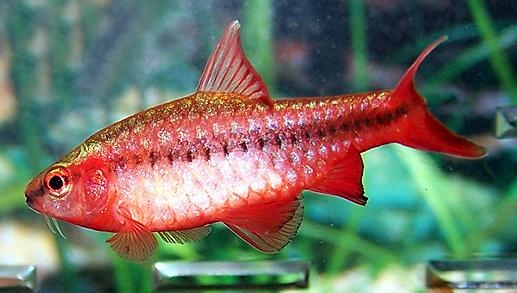Barb - Cherry
Scientific Name: Barbus titteya
Sun, 13th July, 2025 - 8:17 am GMT
Sponsor Ads:

Alternative Name
Scientific Name: Barbus titteyaBasic Info
Named after their bright red body, the Cherry Barb is a beautiful fish and a must for any community tank. At maturity, they reach an average size of about two inches. Males can be differentiated be their brighter color. Females will tend to have a larger body than the males as well.
Health
Cherry Barbs are an easy fish to care for. They do not need special attention, and are rather hardy. They should be kept in water with a temperature range form 76 to 80 degrees Fahrenheit. The pH level of the water should be neutral, with a range from 6.6 to 7.2. Cherry Barbs are omnivores, and can be fed the standard fish foods, worms (glass, blood and tubifex), brine shrimp, plankton, flake and freeze dried foods. They should also be fed various green vegetables, such as spinach, zucchini, peas and lettuce. Breeding When spawning, the male will grow a little larger and become more full bodied. The male Cherry Barb will also be a brighter red when breeding. Cherry Barbs will scatter their eggs, which will number at around 300. After spawning, the parents should be removed from the tank. The eggs should hatch after about two days, and the fry should be fed prepared fry food, strained boiled egg yolks, baby brine, or microwormHabitat
Fresh water fishBehavior
The Cherry Barb, or Barbus Titteya is beautiful and peaceful. It breaks the conception that every Barb is aggressive. Like other Barbs, they are fairly hardy and easy to care for, needing little attention. Cherry Barbs are probably the most timid in the Barb Family. They especially shy away from other cherry barbs. It is recommended that only a few be kept in a tank. They will most likely not school with each other, and will even go so far as to hide from each other. Cherry Barbs will, however, sometimes school with other species of fish. They should be kept in community tanks with dense vegetation, a moderate amount of rocks, and driftwood. Live plants are acceptable, but the Cherry Barb may nip on them. Being loners by nature, they should have plenty of places to hide as well. A tank with a dark substrate will make the color of the fish seem brighter.Origin
Sri LankaHistory
The Cherry Barb is originally found in dimly lit streams in Sri Lanka. They can be found widely in retail stores.Common Foods
N/ASponsor Ads:
Misery acquaints a man with strange bedfellows. The Tempest . Act ii. Scene. 2, William Shakespeare
Barb - Cherry
Coded by: BGID® | ALL RIGHTS RESERVED Copyright © 2000-2025
Disclaimer | Privacy | Report Errors / Contact | Credits


 President of the United States of America - Real Estate mogul, Pageant owner and now one of the most controversial men in political history.
President of the United States of America - Real Estate mogul, Pageant owner and now one of the most controversial men in political history.  Global warming has been in and out as the "latest" hot topic for many years. It is, according to modern scientists, the result of man-made industrial pollutants, clearing forested areas, agriculture, etc. But now they are thinking it started way before the Industrial Revolution...
Global warming has been in and out as the "latest" hot topic for many years. It is, according to modern scientists, the result of man-made industrial pollutants, clearing forested areas, agriculture, etc. But now they are thinking it started way before the Industrial Revolution...  Politician, US Vice President and President of the USA - Joseph Robinette Biden Jr.
Politician, US Vice President and President of the USA - Joseph Robinette Biden Jr.  versus
versus  Russia: 'The Evil Empire'? Are they all that bad or is it just the USA trying to portray Russia as bad because they are a world power with land bigger and a society very different from the USA ideal?
Russia: 'The Evil Empire'? Are they all that bad or is it just the USA trying to portray Russia as bad because they are a world power with land bigger and a society very different from the USA ideal? 
 Corona virus
Corona virus 
 Users with wide screen monitors can benefit from more content on every page.
Users with wide screen monitors can benefit from more content on every page.